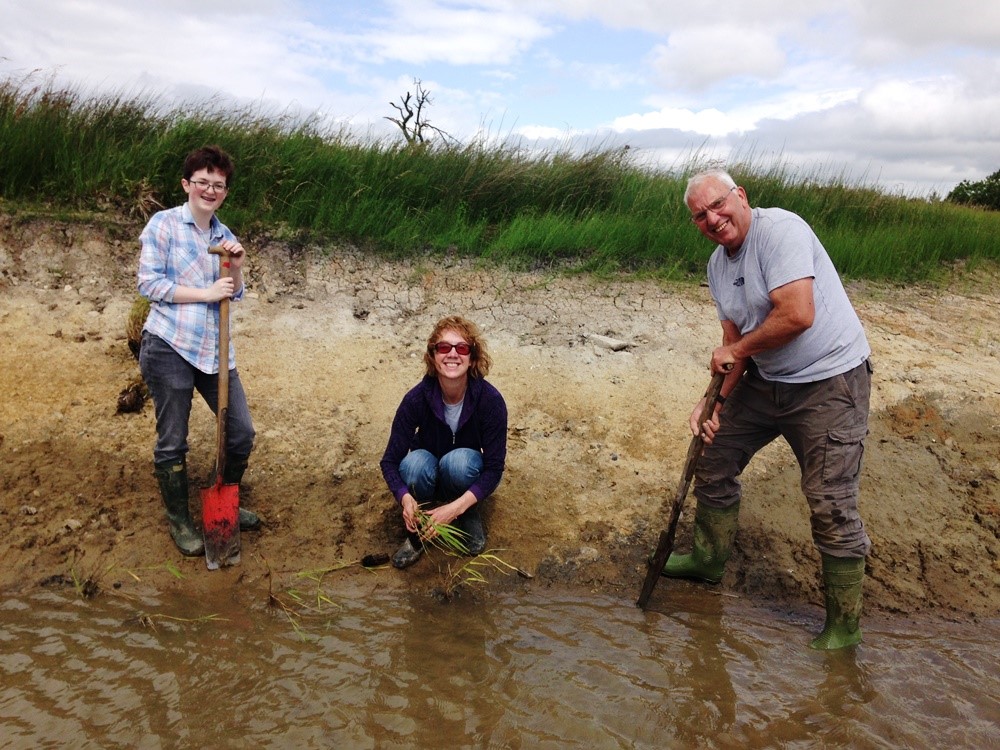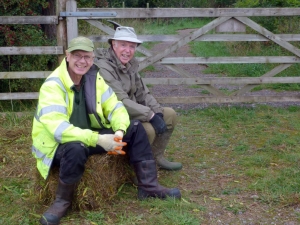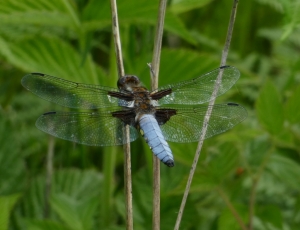Blog Archive (24) Posts Made in February 2015
Mosses
Saturday, February 28th 2015
Mosses are non flowering plants. They do not have a vascular system to transport water and nutrients and so prefer to grow where it is moist. At this time of year, when it is damp and there is very little leaf canopy, mosses can easily be seen at Foxglove. These small plants can be found on tree trunks and branches, on the ground and on log piles. Where lichens have grown on stone and a small amount of substrate has accumulated, mosses will take root. The roots are not like those of flowering plants, but are tiny and threadlike and are called rhizoides.
This feathery moss can be found along the banks of Risedale Beck.
When there is a lack of moisture, mosses can lose water and feel dry when touched. Their appearance changes from bright green to dull green as this one on an Elder branch shows.
These two mosses are both growing on stone.
Mosses reproduce by spores and in damp conditions they begin to produce their spore capsules. Each moss has a different shape of capsule.
Unfortunately they are not the easiest of specimens to photograph and it is back to the drawing board to improve on these two!
Recent Ringing Recoveries
Friday, February 27th 2015
The interactive map below shows a selection of the ringing recoveries that we have received during February 2015. Red lines represent birds that were ringed elsewhere and then controlled at Foxglove. Blue lines represent birds ringed by the Swaledale Ringing Group at one of our sites and then controlled by another ringing group. You can zoom in on the map; to find out more about each recovery click on a line.
Many of these recoveries have come from the two ringing expeditions last summer to Cape Wrath. Particularly noteworthy is the 24 year old Guillemot that was first ringed as a chick in 1990 on the Isle of Canna and controlled by our ringers at Leac Buidhe last summer.
Willow Spiling Continued
Thursday, February 26th 2015
Today was the third day of the willow spiling course here at Foxglove. After the first two days we had all of the stakes knocked in and approximately half of the weaving done.
.jpg)
We again started the day in the classroom getting an understanding of the theory behind riverbank restoration using willow spiling. We then headed out and started where we left off yesterday.
We spent the morning finishing off the weaving of the withies to create the new bank.
In the afternoon we put a layer of hessian behind the willow wall. This will help prevent the material that we use to backfill the bank washing away should the river flood before the willow has had a chance to set root and hold in the bank.

We then used stone and soil from the bank behind the spiling to fill in the gap between the willow and the old line of the bank to create a new stable solid bank.
Everyone has worked really hard over the last three days of the willow spiling course and created something that with a bit of luck will stabilise the bank along Risedale Beck for many years to come.
We would like to thank everyone who has helped complete this project not only have you done a fantastic job but you made it an extremely enjoyable few days!
The Monthly Flower Walk
Wednesday, February 25th 2015
The monthly flower walk was carried out today. By the end of the walk five flowers had been recorded. Daisy was in its usual place by the seat, along Risedale Beck. Opposite-leaved Golden Saxifrage was in flower along the beck sides. This flowers much later in areas by Risedale Beck. Primroses were flowering on one part of the steep sides of Risedale Beck. Gorse is in flower across the moor. There were insects on the wing in and around the Gorse. This tiny weevil, at least that is what it looks like, was on a Gorse flower.
Hazel catkins are beginning to open to release their pollen. The tiny red female flowers are also in bloom, although quite hard to find at times.
Male willow catkins are just bursting their buds but this does not pass the 'open flower' test and so were not recorded on the list.
Other species were examined. A lichen growing almost perfectly in a circle was found on one of the bridge rails. The dark circles in the centre are the fruiting bodies.
These cup lichens probably belong to the Cladonia family.
Scarlet Elf Cup has been on show for some weeks. This one lived up to its name as it had collected water in its cup.
Amber Jelly as it is now known, comes and goes on the willow branches.
Willow Spiling
Tuesday, February 24th 2015
Today six volunteers came to Foxglove to learn the art of willow spiling. Willow spiling is a traditional technique used for stabilising river banks. We started the day with a short classroom session to explain the basics and then headed out into the wind and rain to put the theory into practice.
We are working on a section of Risedale Beck where in the past large sections of the bank have been eroded when the beck is in flood.

The first job this morning was to knock forty willow posts into the bankside. The volunteers worked really hard and had them all in place by lunch time.


This afternoon we then concentrated on weaving willow withies between the posts to create the new bank.

We made excellent progress and have built about half of the structure. Once finished this wall of willow will be filled in with soil and rocks from behind. The willow will then grow and set roots creating a new stable bank.
.jpg)
All the materials used on this project are from the coppicing on the reserve, so this really is an amazingly sustainable way for us to protect the banks of the beck.
Whilst some of us worked on the willow spiling another group of volunteers worked their way through part of the woodland behind Risedale Beck removing lots of dead trees. This area of woodland was part of a plantation and needs ‘thinning out’ as part of its management in order to provide space and light for the other trees to grow. They did an fantastic job and removed lots of trees despite the adverse weather conditions.
It has been a really busy and productive day on the reserve and we would like to thank everyone who has contributed.
Colour, Patterns and Reflections
Sunday, February 22nd 2015
Strong winds have caused damage to some of our trees and these have had to be felled. It does not take long for animals to get used to the changes around them. A squirrel left the shell of a Hazel nut on the cut trunk.
Using a chain saw is a skill and it is amazing to watch as a tree is carefully brought down. On this cut trunk the patterns left by the blade can be seen.
Water Plantain grows in several ponds and flowers in the summer. Now as winter comes to an end the branching seed heads can easily be seen.
With a little cropping of a photograph the reflections made by the vegetation being gently blown by the breeze, makes a delightful pattern.
Views
Saturday, February 21st 2015
Early morning sun was just catching parts of the bank and trees along Risedale Beck.
At this time of year the reeds are brown but still look spectacular against a blue sky.
Several of the net rides have been pollarded. Their stark winter plumage will turn green once spring arrives.
The coppicing of the willow carr has now been completed and this has opened up many different views of the reserve.
Half Term Activity Morning
Friday, February 20th 2015
Today, thirteen children enjoyed a morning of activities during their half term holiday; several games were played as well the arts and crafts activities on offer. Earlier in the week, twigs, pine cones and other natural materials were collected to created decorative mobiles.
The favourite was making a bird feeder to take home out of a foraged pine cone stuffed with lard, seed and nuts. Birds all around the area will enjoy feasting on these over the weekend.
Our new interactive touchscreen also proved a hit with the young visitors, who all enjoyed competing for the top score on the quiz.
Several of the bird ringers were also in this morning, giving a ringing demo to visitors. The children learned about the process of bird ringing and were able to see some of our woodland birds up close.
Our thanks go to everyone who has helped out this morning by planning, preparing and delivering these activities.
Planting
Thursday, February 19th 2015
Our volunteers erected the new feeding station at the wetland today. To stop squirrels jumping across to the feeders, a baffle made from an old metal drum was added.
Once the baffle had been attached the post was lifted into position and set level. We hope that this will attract a wider variety of birds to the wetland area for visitors to watch and enjoy.

The rest of the day was spent planting Larch trees in the woodland area alongside the lake. Several trees here have been lost to storms over the past two years, leaving many large open areas through this section of woodland. Replanting these will help to create a diverse age structure in the woodland which will be beneficial to a wide range of wildlife.
As always, thank you to everyone who has helped out on the reserve today.
First Frog!
Wednesday, February 18th 2015
It was less cold this morning and a frog decided to show itself on the car park. It was some distance away from water, but possibly close to its winter hibnernation site.
Walking through the Scrapes there were no signs of frogs in the ponds. We usually start to listen for them calling around the 23rd February. They may well be a little late this year as the night temperatures are set to be low for the next ten days.
The back garden was very busy with Great, Blue and Coal Tits. Chaffinches, Greenfinches and Blackbirds were also feeding. Bullfinches were enjoying the food in the hopper, but one was seen eating the berries off the Guelder Rose shrub. This is most unusual as not many animals eat these berries and so they can be seen on the trees well into the spring.
During the morning it became less warm and a very strong wind blew through the reserve. Mallard, back on the lake after the ice has melted, were almost lost as the waves blew down the lake.
Coppicing Complete!
Tuesday, February 17th 2015
Today we had an amazing turn out of twenty five volunteers to help us coppice and we are happy to report that apart from a bit of selective thinning of the Hawthorns we have now completed this year’s block!
Everyone worked really hard again today and with such a large turn out an amazing amount was cut down, processed and burnt on the fire. We would like to thank you all for your hard work and determination to finish the job today.
We would also like to extend our thanks to everyone who has helped on this project, whether it be on a Tuesday, Thursday or on a Winter Worky day the work has been done to an exceptionally high standard.
Bird Ringing
Sunday, February 15th 2015
A lie in for the bird ringers this morning with an 8am start.
As always net rounds were carried out regularly and a steady stream of birds were returned to the ringing room. Over 100 new birds were processed during the day, from a total of 161. Surprisingly although up to seven Blackbirds at a time have been counted in the back garden not one was caught today at Foxglove. However Jack, one of the ringing group who rings on Salisbury Plain, contacted us to report that he had a controlled a Blackbird wearing a Danish ring which is quite unusual. Details to follow.
There have been fewer Lesser Redpolls sighted around the reserve over the last few weeks but they more than made up for it today. A total of 39 birds were caught and only four had been ringed previously.
Now that the lake is free from ice the Kingfishers have returned. The female caught today was born and ringed last year.
Views of Foxglove
Saturday, February 14th 2015
Over the last few weeks Foxglove has been covered in snow, with ice on all the ponds and lake. There have been dark, heavy skies and blue skies. Rain, dampness, and wind all thrown in to the mix. Whatever the conditions Foxglove is photogenic.
The pools had some ice but also some unfrozen water which allowed just a hint of reflection of the trees.
Blue skies and white fluffy clouds made it look spring like, but it certainly was not.
The snow melted as the temperature rose slightly, but still remained in some sheltered places, more to come? This view across the Voley pond into the willow carr is truly amamzing.
Soon, well in a couple of months, the view along the Sycamore Avenue will change and the predominant colour will be green again.
A different view of the larch trees near the moor. There are still plenty of cones on these trees and birds can be seen feeding here, flitting from one branch to another.
A gentle breeze caused some ripples across the water surface as this photograph of Cotton Grass was taken.
Log Piles
Friday, February 13th 2015
Plenty of wildlife makes its home in dead wood, and other animals use it as a source of food. In woodlands, fallen wood occurs naturally and many species have adapted to use this habitat. In our increasingly tidy countryside, fallen and dead wood is not so common so we have replicated this valuable habitat by creating a log pile. Invertebrates such as woodlice, earwigs, centipedes and millipedes like to hide in all the nooks and crannies in the logs. Frogs, newts and voles will also use log piles as places to shelter and hibernate. Decaying wood supports a wide range of fungi, including Sulphur Tuft, Candlesnuff and Turkeytail.
Over the winter months visitors and volunteers have enjoyed taking photos of these features that can be seen around the reserve. Shrouded in snow a fortnight ago they looked particularly picturesque.
Team Thursday
Thursday, February 12th 2015
Today with the help of a small but dedicated band of volunteers we continued the coppicing effort in the small section of this year’s block.
The area next to the original ringing shed (which is now the seed store) has been completely transformed over the last few volunteer days.
We are really close now to completing this year’s coppice block hopefully only one more good days work and we will be done.
The work in the block has been done to a really high standard and we are really impressed with the speed that this large area has been coppiced. This is all down the effort of the volunteers, some who were here today but many more who have helped over the last few months. So once again we thank you all for your continued efforts and we really can’t wait to see what pops up in the cleared areas in the spring!
Tuesday Volunteer Day
Tuesday, February 10th 2015
Over twenty volunteers continued working hard in the coppice block today. Large patches of old growth Gorse and Silver Birch at the edge of the block were targeted opening up views through the adjacent conifer trees.
The ground around the fire quickly softened as we worked to clear the cut brash; wellies were essential.
By mid-afternoon we had finished for the day and stood by the fire to enjoy the warmth and the new view that has been opened up.
Work also started preparing a field for the replanting of a bird seed crop. This area will provide a food source for birds over the summer and autumn months hopefully attracting in other species such as Corn Bunting and Yellowhammers. Once the ground has dried out, the farmer will return to harrow the soil before sowing the seed.
Thank you to everyone who has helped out on the reserve today.
Signs of Spring
Monday, February 9th 2015
Warmer weather over the weekend has given the reserve a completely different feeling; the ground is no longer frozen under your feet, although there are a few icy patches lingering on the lake and some ponds. The birds are once again starting to sing and the list of flowers is, ever so slowly, starting to grow, a sure sign volunteers are ‘rooting about’ for signs of spring.
One of the most eagerly awaited sights as the seasons turn is the appearance of the first frog spawn. While this is at least a few weeks off there have been signs that these animals are beginning to become more active.
A clear jelly-like substance can be found in several places at the moment, sometimes containing fine black dots, like in the photo below. Previously this ‘slime’ has been linked to falling meteors fungi and slime moulds; however, it is much more likely to be unfertilised frog spawn from a predated female. Once attacked, it is quite natural for the frog to drop its spawn, which on contact with water or moist ground will swell forming the jelly like substance we can see below.
The earliest we have seen frog spawn in the ponds in recent years was on the 24th February in 2012. We will be keeping an eye out over the next few weeks for this exciting yearly event.
Out and About on a Sunny Day
Sunday, February 8th 2015
The Roe Deer have been seen again and some more photographs taken. There could have been a great one yesterday as Ann waited for five to come closer before taking a photograph, unfortunately she had help. The deer were not very keen on Clemmie, the Boxer, who decided that Ann needed some help!
There were ripples on the pond surface as the Water Vole slid back into the water. Their foot prints were seen in the clay, in the mink raft. A Stoat was seen in the Scrapes. Brambling were in the back garden.
Earlier in the week the ice was thick enough for the Mallards to walk on.
Although we have now had two days where the temperature has risen, much of the lake is still covered in ice. Some of the Mallards were seen on the wetland and one was under the feeders.
As the temperature rose, the bees from the hive took short flights outside.
Brian photographed this Bulrush that was just beginning to release it seeds.
The seeds are tiny and are dispersed by the wind.
At this time of year we are all keeping our eyes open for the first signs of spring, even though we know it is a few weeks away. Primrose has been recorded and Opposite Leaved Golden Saxifrage passed the flower test and was noted on the Observation Board today. Surprisingly, one Hazel tree not only had its catkins open to release its pollen, but also the tiny red female flowers.
And finally, as Brian walked through the reed bed with the sun low and the temperature just beginning to drop he photographed the reeds against the blue sky.
February Winter Worky Day
Saturday, February 7th 2015
Over thirty volunteers joined us on the reserve today for the fifth Winter Worky Day of the season. The work site was only a stone’s throw from the Field Centre, where we worked on the last small section of willow coppicing and pollarding along one of the net rides.
Many ‘regulars’ joined us today as well as some first time volunteers who got stuck in and enjoyed learning new skills.
The junior work team was also out in force; armed with their pruning saws and loppers they cleared several willow stools and helped to keep the fire going.
After a morning’s hard work everyone was rewarded with a tasty curry, and to top it off a selection of homemade cakes made by our volunteers – thank you to everyone who contributed to the delicious spread.
Much of the afternoon was spent clearing the huge amount of cuttings from earlier in the day.
Thank you to everyone who has helped out, it has been a very enjoyable and productive day out in the fresh air with such good company.
Badgers
Friday, February 6th 2015
In the recent snow we have been searching for clues as to what animals are out and about. Tracks are a brilliant way to do this and can reveal the habits of some of the less frequently seen animals. We have seen evidence of Roe Deer, Fox, and many birds. One of the more exciting finds over the last week was Badger prints all the way along the boardwalk through the scrapes, giving us clues as to where these elusive animals visit and walk on their nocturnal excursions.
Just before Christmas, Ken had his camera out again and has captured four short clips of a Badger on the reserve, which can all be enjoyed in the video below.
Thank you Ken for your efforts in getting this brilliant footage and allowing us to use it on the blog.
Getting Ready for the Weekend
Thursday, February 5th 2015
With the ground still frozen today’s plans of planting Larch trees and installing the new feeding station at the wetland have had to be postponed. Volunteers instead found themselves starting work on the final section of the coppice block and preparing the site for the Worky Day this coming Saturday.
Willow and invasive species such as Silver Birch and Gorse were cut and cleared during the day.
A good start was made and space created for the 30 or more volunteers we have coming to help on Saturday to get stuck in.
Thank you for all your hard work today!
Team Tuesday
Tuesday, February 3rd 2015
Nineteen volunteers spent their day helping us to continue work from the last Winter Worky Day - clearing along an overgrown beck near to the lake.
Small areas of Gorse were also cleared along the path and we are hoping wildflowers will be seen in bloom here during the spring and summer.
Much of the wood we cut today was burned but where we could we used it to rebuild the dead hedge that runs along the path and created some habitat piles which will be enjoyed by a variety of animals.
The group worked hard and were rewarded with some delicious scones that Ann had baked earlier this morning. The weather was fantastic; almost spring-like with the warming sun on our faces as we worked.
The work was completed during the afternoon and has really made a difference to this area of the reserve. Thank you to our volunteers for your hard work today.
Roe Deer
Monday, February 2nd 2015
Volunteers and visitors have been reporting good sightings of Roe Deer over the past few weeks. Most of the time these are fleeting glimpses through the trees as they make a hasty escape when people approach; good photos of them are hard to come by. Both Mike and Brian have had luck on their side and managed to capture these two brilliant photographs.
The males have already started to develop their antlers ready for the rutting season in the summer. Two small furry lumps can be seen on the deer in the photo below; these will develop into the antlers and should be fully grown by May. They grow with velvet around them which aids blood supply to the soft, growing tissue. Once the antlers are fully grown they harden and the velvet falls off.
Ian also gave us this artistic image of a sunset over the lake.

Thank you all for allowing us to use your photographs.
Birds
Sunday, February 1st 2015
Bramblings have been absent from Foxglove so far this winter. The first one to arrive made its appearance on the day the birds were being counted for the RSPB Bird Watch, but as stated in the blog for that day it did not reappear to be recorded! However over the last week more of these beautiful winter migrants have been seen in the back garden.
It is at this time of year that all the bird ringing data must be inputted into IPMR and sent to the BTO. A huge task, even though the data from ringing at Foxglove is entered as we ring. In 2014, 9992 birds were processed from sites which included Foxglove and the surrounding training area as well as Cape Wrath. There were 7881 new birds, 2058 retraps and 29 controls.
A huge thank you to all the bird ringers who turn out at dawn for CES, spend many evenings in the spring walking up and down steep hills to ring chicks in nest boxes and Tony for inputting all the data.
It will not be long before the whole cycle starts all over again, tawnies from April and CES in May! How exciting!

























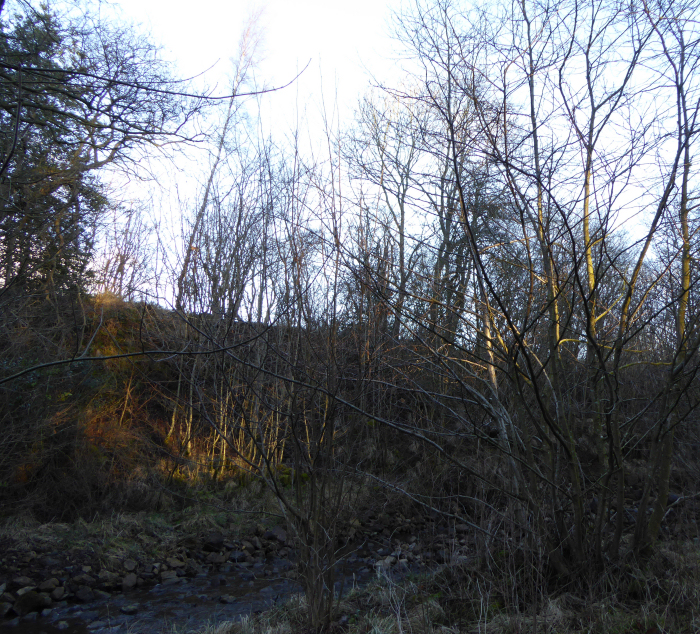
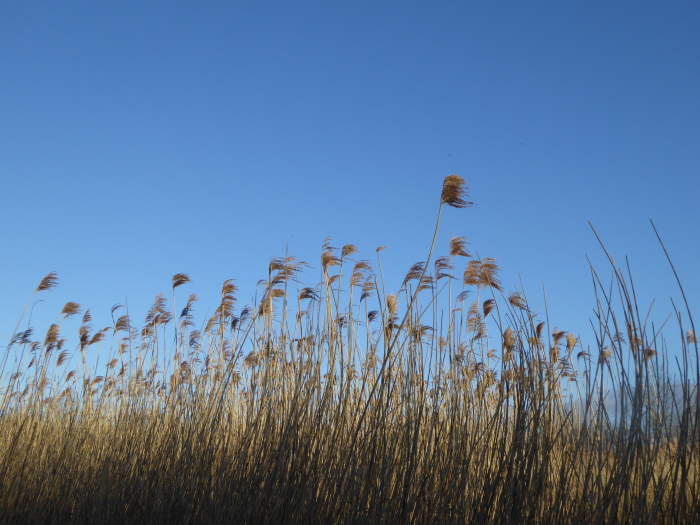
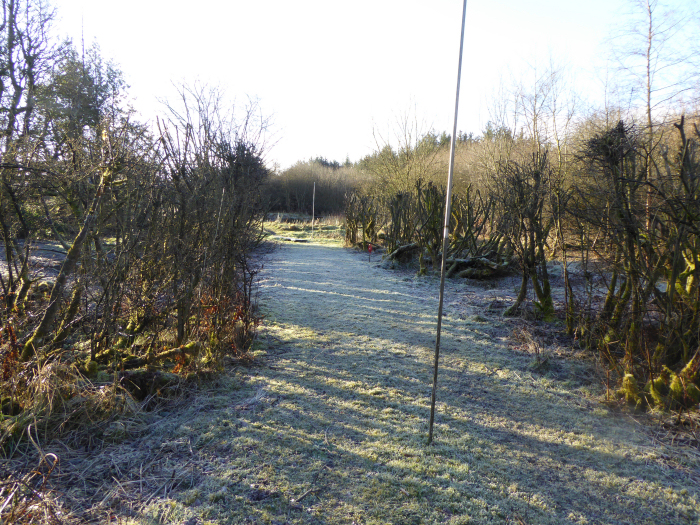
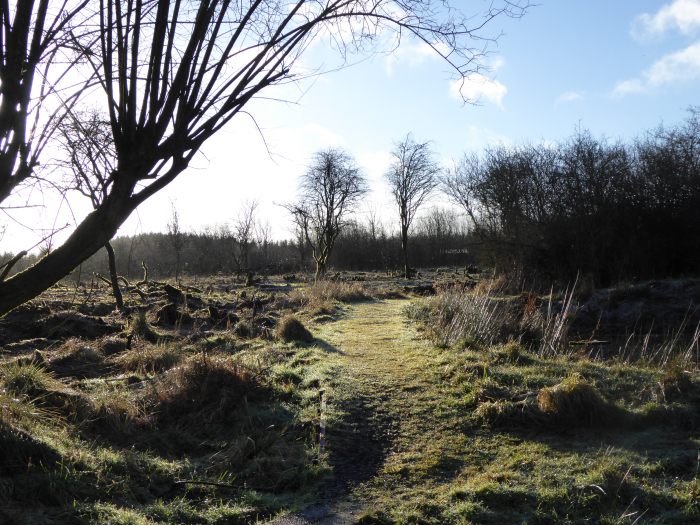











































.JPG)









